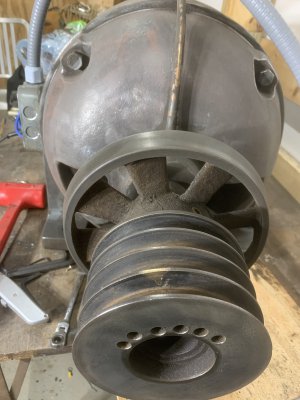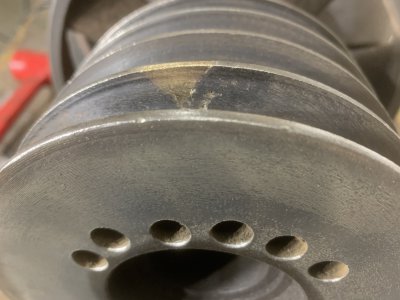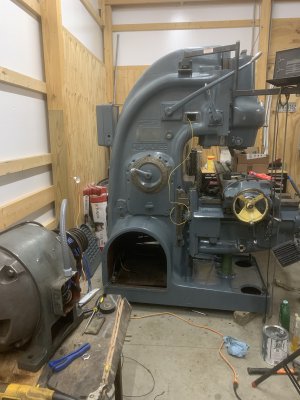-
Welcome back Guest! Did you know you can mentor other members here at H-M? If not, please check out our Relaunch of Hobby Machinist Mentoring Program!
You are using an out of date browser. It may not display this or other websites correctly.
You should upgrade or use an alternative browser.
You should upgrade or use an alternative browser.
Just acquired K&T #3 vertical
- Thread starter rabler
- Start date
- Joined
- Feb 25, 2021
- Messages
- 3,130
Got a little carried away painting, highlighted the lettering in the casting.
Decided the motor is going to get the bearings re-greased and go back in without disassembly. This one has plugs that can be opened to let old grease out, much easier while the motor is out. Seems to spin fine without any catches. Too many projects with both the 10EE and 612 in repair, so plan is to put the motor back in with new wiring, drain, flush, and refill all oil reservoirs, and (hopefully) run it for while.
These are thumbnails so they can be opened for detailed view.
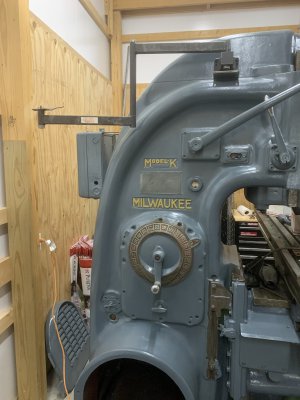
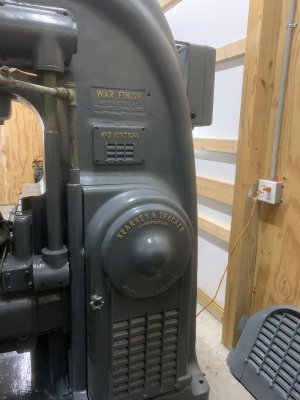
Decided the motor is going to get the bearings re-greased and go back in without disassembly. This one has plugs that can be opened to let old grease out, much easier while the motor is out. Seems to spin fine without any catches. Too many projects with both the 10EE and 612 in repair, so plan is to put the motor back in with new wiring, drain, flush, and refill all oil reservoirs, and (hopefully) run it for while.
These are thumbnails so they can be opened for detailed view.


- Joined
- Nov 24, 2014
- Messages
- 3,179
Looking great. I hadn't noticed the "WAR FINISH" nomenclature before. Your giving that machine a "refreshment" and safe home strikes me as almost patriotic. Maybe I'm getting a bit sappy. Regardless, good job.
- Joined
- Feb 25, 2021
- Messages
- 3,130
I can certainly get a bit sappy about these older machines. They definitely are from a different era, of “big American iron”. And lots of indirect ties to my family as I mentioned earlier. It is not the economical or time-efficient way to set up a machine shop, but it is a passion. Which, I guess, is what being a hobby is about.Looking great. I hadn't noticed the "WAR FINISH" nomenclature before. Your giving that machine a "refreshment" and safe home strikes me as almost patriotic. Maybe I'm getting a bit sappy. Regardless, good job.
- Joined
- Feb 25, 2021
- Messages
- 3,130
It LIVES!
It's operational. Yesterday I powered it up for the first time since bringing it home. It's really cool how this 1944 machine works. 10HP motor directly into a clutch. From the clutch in addition to the spindle, the motor drives table X & Y feeds, table height, and head height. No quill but the entire head moves up and down. Setting dial on the front is calibrated in IPM. Rapids is a large handle under the table on the right, engage that and things move fast.
The only thing I don't like about the old technology is there really is no emergency stop. The stop switch is around the left side of the machine and given the size of the machine it requires walking around the table to reach. The clutch can of course be disengaged. But that is a large handle up at head height on the left. I may attach a bar around the base attached to an e-stop switch, so a foot switch to stop it is easy to kick.
I'm draining the oil out of the spindle right now (1/2 quart) as it looked awful. The main reservior for the gearbox is 4 gallons. Another gallon for the table power feed gears. Time to order some new oil. I'll need to clean or replace the all the way wipers, and the bib on the Y travel. Then run it for a while to see what needs work.
It's operational. Yesterday I powered it up for the first time since bringing it home. It's really cool how this 1944 machine works. 10HP motor directly into a clutch. From the clutch in addition to the spindle, the motor drives table X & Y feeds, table height, and head height. No quill but the entire head moves up and down. Setting dial on the front is calibrated in IPM. Rapids is a large handle under the table on the right, engage that and things move fast.
The only thing I don't like about the old technology is there really is no emergency stop. The stop switch is around the left side of the machine and given the size of the machine it requires walking around the table to reach. The clutch can of course be disengaged. But that is a large handle up at head height on the left. I may attach a bar around the base attached to an e-stop switch, so a foot switch to stop it is easy to kick.
I'm draining the oil out of the spindle right now (1/2 quart) as it looked awful. The main reservior for the gearbox is 4 gallons. Another gallon for the table power feed gears. Time to order some new oil. I'll need to clean or replace the all the way wipers, and the bib on the Y travel. Then run it for a while to see what needs work.
- Joined
- Nov 14, 2020
- Messages
- 1,756
After you run it for a bit you will get used to the big levers...lol for starting and stopping the spindle and feeds.
The fastest way to stop one of these or one of the knee mills is those levers, you hit an e stop and everything will coast to a stop.
At first it is a little unnerving but it's not bad after using it some.
The fastest way to stop one of these or one of the knee mills is those levers, you hit an e stop and everything will coast to a stop.
At first it is a little unnerving but it's not bad after using it some.
- Joined
- Feb 25, 2021
- Messages
- 3,130
Now things get expensive. I'm thinking I need a matched set of 6" milling vises. Another set of step clamps. And am debating between 3 axis or 4 axis DRO. I'm leaning toward DRO-Pro since I have one on my working lathe, and being able to learn one DRO setup/operation would help my addled mind from getting confused  Those items will total significantly more than I have into the thing already.
Those items will total significantly more than I have into the thing already.


